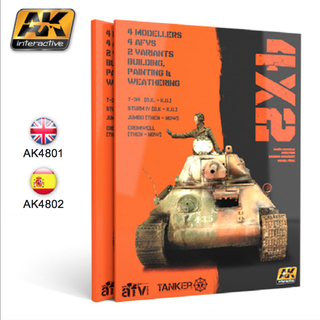 Loading... Please wait...
Loading... Please wait...Blog - 4 x 2
AK Interactive 4 x 2 book review
Posted by Glen Broman on 24th Aug 2015

Never underestimate the power of imagination in small groups of modelers. Most of you have experienced this at a club meeting or a discussion at a show over a few beers when the talk turns to methods on how to achieve certain effects on your latest project. The good ideas start floating around and I am usually amazed at both the elegance and simplicity of the solutions. I digress here just to give a bit of advice, make sure you write down the good stuff before the few beers turn into more than a few beers. Trust me on this, been there and got the T-shirt.
You may be struggling to find the relevance of a modeler’s imagination to a product review, but stick with me for minute. I was talking to Dave Youngquist, the owner and resident Renaissance man at Last Cavalry a few weeks ago and he told me about a new book from AK Interactive on building, painting and weathering tanks. As you know, it can be difficult to decide whether to purchase a product sight unseen. To be honest, a number of products out there today are getting a bit formulaic. So this gets me back to my statement on the power of imagination of modelers in small groups. As soon as I picked this up I realized that this was not only a fresh concept, but done to a very high standard. “4X2” is a 136 page softcover book by four internationally recognized modelers, each building two different versions of the same vehicle. But wait, there’s more! The two builds of each vehicle depict the subject in the early days of its life cycle and the second at the end. This is a fresh idea and I can easily imagine this stemming from the synergistic effect of a few modelers discussing the project in its early stages. Being armor modelers, I’m sure a few beers probably gave their lives to help this project come to fruition.
The four modelers are Ruben Gonzalez, Sven Frisch, Domingo Hernandez and Michel Perez, familiar names from the modeling press. The projects are the Sturmpanzer IV with the initial build showing the unpainted vehicle at the factory and the second knocked out on the Eastern Front. Next up is the M4A3E2 Sherman Jumbo “Cobra King” of the famous 37th Tank Battalion at the Relief of Bastogne during the Battle of the Bulge. This build format is “then and now” with the second being of the tank as it awaits restoration. Having been a tank commander in the 37th Armor and having met a number of our Regimental veterans from WWII, this one was a particular favorite. The third build is also a “then and now” format, a Cromwell Mark IV in the bocage of Normandy and mounted on a plinth as a war memorial outside of Caen. The final build is two versions of the iconic T-34/76, the first a Model 43 from Zavod 183 called Heroes of Leningrad, the second a Model 42 from Zavod 112 destroyed during the fighting for Budapest.
This is a high quality product, the photographs are exceptionally clear and of a high enough definition to clearly show the effects demonstrated in each picture. One other editorial choice I appreciate is the contrast between the printing and the background. It’s very well done and makes the text very easy to read. Unfortunately, there are a number of editors out there today that seem to want to go a little too Gucci on their text and backgrounds creating something more reminiscent of a High School graphics project than a professionally produced product. You know who you are. The format is step by step with numbered captions and photos to clearly walk you through all of the techniques used in each step. No matter what your skill level, there are some nice techniques to try on your next project.
There is some basic build information on each project, but the meat and potatoes are the painting and weathering. The broad spectrum of techniques really makes this book a keeper in my opinion. The final touch is a short “how to” for some of the diorama settings.
I have one somewhat schizoid concern about the book. On the one hand, it’s probably too good to keep on the bench as a technique reference when building for fear of spilling paint or glue on it. On the other hand, I really would like to use it that way, but the binding makes it difficult to keep the page open for articles in the front or rear of the book. You will have to find something to hold it on to the page you are working from. And once again, being a ham fisted old Tanker who thinks a hammer is a precision instrument, I’m paranoid as heck about spilling stuff on it. As usual with a collaborative project with multi-lingual input, some of the word choices and phrasing sounds a bit unusual to the native English speaker, but the text is easily understandable.
This is a great addition to my library and will be a useful reference for several projects I have sitting on my bench right now. I purchased my copy from Last Cavalry at www.latscavalry.com.
